Guerlain
Guerlain (French pronunciation: [ɡɛʁlɛ̃]) is a French perfume, cosmetics and skincare house, which is among the oldest in the world. Many traditional Guerlain fragrances are characterized by a common olfactory accord known as the "Guerlinade". The house was founded in Paris in 1828 by the perfumer Pierre-François Pascal Guerlain. It was run by the Guerlain family until 1994, when it was bought by the French multinational company LVMH. Its flagship store is 68, Avenue des Champs-Elysées in Paris.[1]
_detail_by_shakko.jpg) | |
| Founded | 1828 (192 years ago) |
|---|---|
| Founder | Monsieur Pierre-François-Pascal Guerlain |
| Headquarters | Levallois-Perret, France |
| Products | Perfumes Cosmetics Skin care Hair care |
| Revenue | |
| Parent | LVMH |
| Website | Homepage Guerlain |
History
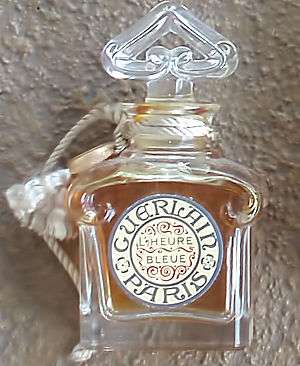
The House of Guerlain was owned and managed by members of the Guerlain family from its inception in 1828 to 1994. It was acquired in 1994 by the LVMH group, a French multinational investment corporation specializing in luxury brands.
Beginning
The House of Guerlain was founded in 1828, when Pierre-François Pascal Guerlain opened his perfume store at 42, rue de Rivoli in Paris. As both the founder and first perfumer of the house, Pierre-François composed and manufactured custom fragrances with the help of his two sons, Aimé and Gabriel. Through continued success and the patronage of members in high society, Guerlain opened its flagship store at 15, rue de la Paix in 1840, and put its mark on the Parisian fashion scene.
The success of the house under Pierre-François peaked in 1853 with the creation of Eau de Cologne Impériale for French Emperor Napoleon III and his Spanish-French wife Empress Eugénie. This perfume earned Pierre-François the prestigious title of being His Majesty's Official Perfumer. Guerlain went on to create perfumes for Queen Victoria of the United Kingdom and Queen Isabella II of Spain, among other royalty.
Second generation
With the death of Pierre-François in 1864, the house was left to his sons Aimé Guerlain and Gabriel Guerlain. The roles of perfumer and manager were divided between the two brothers, with Gabriel managing and further expanding the house, and Aimé becoming the master perfumer. The House of Guerlain thus began a long tradition whereby the position of master perfumer was handed down through the Guerlain family.
As Guerlain's second generation in-house perfumer, Aimé was the creator of many classic compositions, including Fleur d'Italie (1884), Rococo (1887) and Eau de Cologne du Coq (1894). However, many would argue that his greatest composition was 1889's Jicky, the first fragrance described as a "parfum" rather than an eau de cologne, and among the first to use synthetic ingredients alongside natural extracts.
Third generation
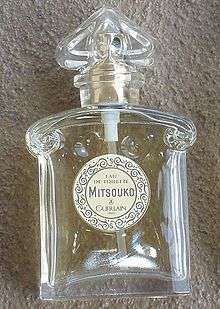
The business was handed down to the sons of Gabriel Guerlain: Jacques Guerlain and Pierre Guerlain. Jacques, Aimé's nephew, became Guerlain's third master perfumer; he was the author of many of Guerlain's most famous classics, which are still held in high esteem in the modern perfume industry. Many of his perfumes are still sold and marketed today. Among Jacques Guerlain's most important creations are Mouchoir de Monsieur (1904), Après L'Ondée (1906), L'Heure Bleue (1912), Mitsouko (1919), Guerlain's flagship fragrance Shalimar (1925), and Vol de Nuit (1933). Jacques composed his final perfume, Ode (1955), with the assistance of his grandson, the then-18-year-old Jean-Paul Guerlain.
Fourth generation
Jean-Paul Guerlain was the last family master perfumer. He created Guerlain's classic men's fragrances Vétiver (1959) and Habit Rouge (1965). He also created Chant d'Arômes (1962), Chamade (1969), Nahéma (1979), Jardins de Bagatelle (1983), and Samsara (1989), as well as Héritage and Coriolan in the 1990s. Jean-Paul Guerlain retired in 2002, but continued to serve as advisor to his successor until 2010, when he was terminated after making a racist remark on French television regarding the inspiration for his scent Samsara.[2] With no heir from within the Guerlain family to take over, the role of master perfumer is no longer tied to family succession.
Purchase by the LVMH Group
In a decision widely seen as a break with tradition, the Guerlain family sold the company to the luxury goods conglomerate Moët Hennessy Louis Vuitton (LVMH) in 1994. Though Jean-Paul Guerlain remained as an in-house perfumer until 2002, other perfumers were brought in after 1994 to compose perfumes for Guerlain, and Jean-Paul had to submit his compositions against those of others. Fans of the house viewed the LVMH purchase as a step towards the cheapening and commercialization of the legendary firm's legacy. Most were unhappy with the first post-LVMH release, the 1996 sweet mimosa floral Champs-Elysées, composed by Olivier Cresp, whose entry was selected over that of Jean-Paul Guerlain.
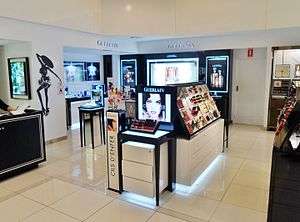
Among the outside perfumers to compose perfumes for the firm after 1994 was Mathilde Laurent, who worked for Guerlain at the end of the 1990s and in the early 2000s. She composed Aqua Allegorica Pamplelune (1999) and Shalimar Light (2003, reattributed to Jean-Paul Guerlain and relaunched in 2004 following reformulation). Maurice Roucel, a perfumer of Symrise, composed L'Instant de Guerlain (2004) and Insolence (2006). As the niece of Jean-Jacques Guerlain, some thought Patricia de Nicolaï would have been a candidate for the position of Guerlain's in-house perfumer,[3] though the presence of a glass ceiling in the company prevented her selection for position.[4]
In May 2008, Thierry Wasser was named the in-house perfumer for Guerlain. Wasser, a Swiss perfumer who used to work for Firmenich, created Iris Ganache (2007) and Quand Vient la Pluie (2007) for Guerlain before his appointment the following year. Jean-Paul Guerlain stayed on in an advisory consultant role, both for fragrance design and ingredients. Wasser will work closely with Sylvaine Delacourte, Guerlain's Artistic Director.[5] In 2010, the LVMH Group cut ties with Jean-Paul Guerlain as their consultant due to his racist comments on French television.[6][7][8]
Russian model Natalia Vodianova has been the face of Guerlain campaigns since 2008. Vodianova began advertising Shalimar to celebrate the perfume house's 180th birthday.[9] For the Fall 2013 makeup collection, Olivier Echaudemaison, Guerlian's Creative Director of Makeup since 2000[10] commented "Every season we fantasize with Natalia's image and invent for her a new role. For us, it is not just a model, which advertises cosmetics, but above all, a great actress".[11] In October 2011, the company named Malaysian actress Michelle Yeoh as a new spokesmodel. Yeoh is an ambassador for the Orchidée Impériale line of skincare.[12]
Products
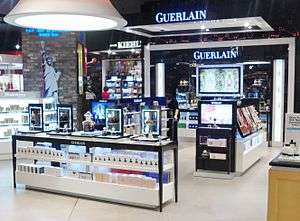
Guerlain's creations have long influenced the trends of perfumery with fragrances such as Jicky, Shalimar, and Vétiver. Guerlain is among the few older houses (such as Caron) that exist solely to produce and market perfumes. Many brands in the perfume industry, such as Chanel and Jean Patou are in fact divisions of fashion houses or multinational conglomerates that license the brand name. Alongside its fragrances, today Guerlain has expanded to offer a large range of makeup and skincare. Guerlain products are available across the world at serviced counters within department stores, and at beauty stores such as fellow LMVH brand Sephora. Guerlain also maintains thirteen international beauty and spa 'boutiques', five within France (two being in Paris).[13]
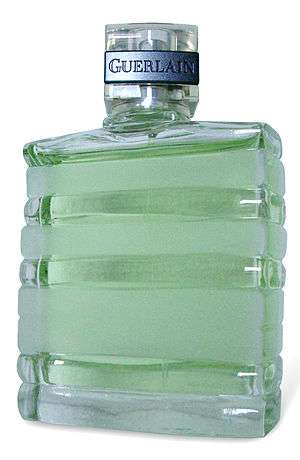
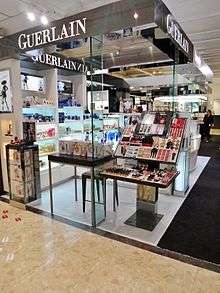
Perfumes
- Eau de Cologne Impériale (1853) (pronounced [od kɔlɔɲ ɛ̃peʁjal]): Guerlain composed this classic cologne, with rich lime and lime-flower notes, as a gift for Empress Eugénie, the wife of French emperor Napoléon III. She liked the composition so much that she named Guerlain an official purveyor of colognes and toiletries to the imperial family. Over a century and a half later, the cologne is still in regular production.
- Jicky (1889) [ʒiki]: Said to be named either after the nickname Aimé Guerlain gave to his nephew, Jacques, or after a girl who broke Aimé's heart as a student in England, Jicky is widely heralded as the first "modern" fragrance, and the first to be referred to as a perfume. Jicky was among the first fragrances to incorporate synthetic odorants (vanillin and coumarin) in its composition, and is described by some as being the "ultimate" fougère. The fragrance is known for its main notes of lavender and vanilla over animalic civet. Although marketed by Guerlain as a women's fragrance, it was initially more successful with men and has proven to be a popular unisex fragrance. Over 120 years later, Jicky is still being sold, making it the oldest fragrance (other than colognes) in continuous production.
- Après L'Ondée (1906) [apʁɛ lɔ̃de]: Meaning "After the rain shower," Après L'Ondée is a light floral fragrance reminiscent of bitter almonds, with anise and herbal notes. Its composition includes violet, rose, heliotrope, hawthorn, anise, and citrus notes.
- L'Heure Bleue (1912) [lœʁ blø]: Meaning "The Blue Hour," L'Heure Bleue is a floral oriental fragrance with the dusky scent of candies and almond cake bought in an old world apothecary. Its powdery accord is similar to that of Après l'Ondée, but L'Heure Bleue is denser, richer, and has a more confectionery quality, while Apres l'Ondée has a more floral character, particularly in its violet notes, and is perhaps more clear and open. Both Apres l'Ondée and L'Heure Bleue are often perceived as melancholy scents.
- Mitsouko (1919) [mitsuko]: Named after the heroine of the novel La Bataille by Claude Farrère, Mitsouko is said to herald the ending of World War I. Due to a bottle shortage at the end of the war, it was marketed in an identical bottle to that of L'Heure Bleue, and is sometimes considered to be that fragrance's warm counterpart. The structure is based on Coty's 1917 perfume Chypre, with added notes of peach and iris. With Coty's fragrance long since discontinued, Mitsouko is today considered by Luca Turin, a well-known perfume critic and reviewer, to be a reference fragrance in the chypre olfactive family.[14]
- Shalimar (1925) [ʃalimaʁ]: Named after the garden in Lahore, built by Shah Jahan in memory of his wife, Shalimar is one of the world's most famous oriental fragrances, and was one of the first perfumes to successfully incorporate large amounts of vanillin in its composition. The scent of Shalimar is densely constructed, with a cascade of many notes, including bergamot, tonka bean, iris, and vanilla. This is the flagship perfume of the House of Guerlain.
- Vol de Nuit (1933) [vɔldənɥi]: Composed as a tribute to flight, celebrating the novel of the same name by pilot Antoine de Saint-Exupéry and Air France, this is a green, semi-oriental chypre with notes of iris, galbanum, daffodil, and oakmoss. Vol de Nuit's use of galbanum made it the first fragrance to feature pronounced green notes.[15]
- Chamade (1969) [ʃamad]: Named after the novel by Françoise Sagan, Chamade is a floral oriental fragrance with a pronounced topnote of galbanum introducing a core of notes including hyacinth, blackcurrant buds, and vanilla. In French, the word "Chamade" refers to a particular rapid drumbeat used by Napoleon's armies to signal an order to retreat. Packaged in a bottle representing an upside-down heart pierced by an arrow, the fragrance is said to symbolize a total surrender to love.
- Nahéma (1979): This floral oriental fragrance was inspired by the legend of a sultan who had twin daughters, the gentle and obedient Mahane and the fiery and passionate Nahéma. Built predominantly around rose notes, Nahéma was an early fragrance to feature damascenones, a set of newly discovered aromachemicals with a profound fruity-rose character.
- Samsara (1989) [sɑ̃saʁa]: Composed by Jean-Paul Guerlain, this is a heady oriental fragrance featuring main notes of jasmine, ylang-ylang, and sandalwood. The name is a reference to the cycle of birth, life, death, and rebirth or reincarnation in Hinduism and many other religions in South Asia.
Since its foundation in 1828, Guerlain has created over 300 fragrances. These include:
| Name | Year |
|---|---|
| Eau de Cologne Impériale | 1853 |
| Jicky | 1889 |
| Eau de Cologne du Coq | 1894 |
| Mouchoir de Monsieur | 1904 |
| Voilette de Madame | 1904 |
| Parfum des Champs-Élysées | 1904 |
| Après l'Ondée | 1906 |
| Kadine | 1911 |
| L'Heure Bleue | 1912 |
| Mitsouko | 1919 |
| Eau de Fleurs de Cédrat | 1920 |
| Shalimar | 1925 |
| Liù | 1929 |
| Sous le Vent | 1933 |
| Vol de Nuit | 1933 |
| Vega | 1936 |
| Coque d'Or | 1937 |
| Ode | 1955 |
| Vetiver | 1956 |
| Chant d'Arômes | 1962 |
| Habit Rouge | 1965 |
| Chamade | 1969 |
| Eau de Guerlain | 1974 |
| Parure | 1975 |
| Nahéma | 1979 |
| Jardins de Bagatelle | 1983 |
| Derby | 1985 |
| Samsara | 1989 |
| Héritage | 1992 |
| Champs-Élysées | 1996 |
| Aqua Allegoria Pamplelune | 1999 |
| Aqua Allegoria Herba Fresca | 1999 |
| Mahora / Mayotte | 2000 |
| L'Instant de Guerlain | 2003 |
| Insolence | 2006 |
| Guerlain Homme | 2008 |
| Idylle | 2010 |
| La Petite Robe Noire | 2012 |
| L'Homme Idéal | 2014 |
| Mon Guerlain | 2017 |
| Météorites | 2018 |
References
- "Champs-Elysées stores and shops". Paris Digest. 2018. Retrieved 19 October 2018.
- Samuel, Henry (29 March 2012). "Jean-Paul Guerlain fined for racist comment". The Telegraph. Retrieved 17 November 2012.
- Chandler, Burr (2003), The Emperor of Scent: A Story of Perfume, Obsession, and the Last Mystery of the Senses, New York: Random House, ISBN 0-375-50797-3
- Atkinson, Nathalie (20 December 2010), "Scent of a woman: Patricia de Nicolai on circumventing the Guerlain gender bias", National Post
- osMoz, Guerlain hires perfumer Thierry Wasser, archived from the original on 20 May 2008, retrieved 28 May 2008
- Jean-Paul Guerlain speaking about negros
- Brisson, Cecile (30 March 2012). "Guerlain cosmetic empire heir convicted of racism". Times Union.
- "Perfumier Jean-Paul Guerlain guilty of racism". Al Jazeera. 29 March 2012.
- fragrantica.com (27 September 2008), Natalia Vodianova – New Face of Guerlain, retrieved 13 July 2013
- https://www.facebook.com/Guerlain/info
- BecomeGorgeous (9 July 2013), Guerlain Fall 2013 Violette de Madame Collection, archived from the original on 13 July 2013, retrieved 13 July 2013
- Chau, Elizabeth (13 October 2011), Michelle Yeoh Named as Guerlain's New Celebrity Ambassador, archived from the original on 13 July 2013, retrieved 13 July 2013
- http://www.guerlain.com/int/en/base.html#/en/patrimoine-guerlain/lepatrimoine-subtitle/lepatrimoine-boutiquesspas/
- Luca Turin and Tania Sanchez, Perfumes: the A–Z Guide, Expanded Edition, Penguin, 2009, 384–5.
- Roja Dove, The Essence of Perfume, London: Black Dog Publishing, 2008, 116.
Further reading
- Stamelman, R: "Perfume – Joy, Obsession, Scandal, Sin". Rizzoli. ISBN 978-0-8478-2832-6. A cultural history of fragrance from 1750 to the present day.
- Collectif, Dictionnaire des parfums - 10e édition 1990–1991, Sermadiras, 1990, 304 p.
- Élisabeth de Feydeau, Le roman des Guerlain. Parfumeurs de Paris, Flammarion, 2017, 363 p. (lire en ligne)
- Pierre-Roland Saint-Dizier (scénario), Li-An (dessin), Guerlain, Le prince des parfums, 1ère époque, Pierre-François-Pascal (1798/1864), bande dessinée, Glénat, 2018
External links
| Wikimedia Commons has media related to Guerlain. |
- Official website
- Corporate webpage of LVMH, owner of Guerlain